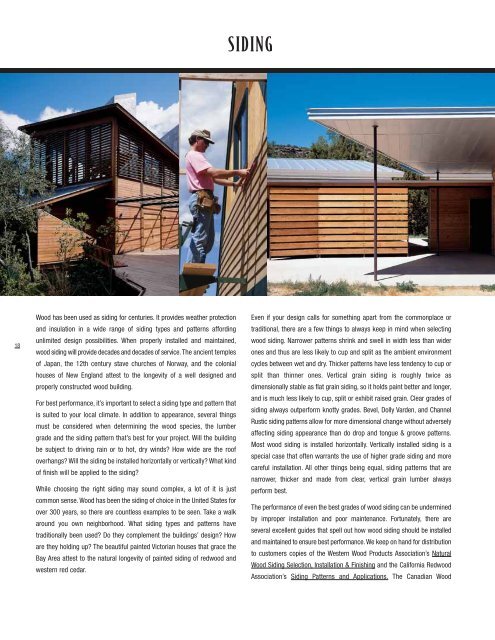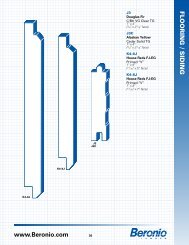Paneling and Siding Catalog - Beronio Lumber
Paneling and Siding Catalog - Beronio Lumber
Paneling and Siding Catalog - Beronio Lumber
Create successful ePaper yourself
Turn your PDF publications into a flip-book with our unique Google optimized e-Paper software.
18<br />
Wood has been used as siding for centuries. It provides weather protection<br />
<strong>and</strong> insulation in a wide range of siding types <strong>and</strong> patterns affording<br />
unlimited design possibilities. When properly installed <strong>and</strong> maintained,<br />
wood siding will provide decades <strong>and</strong> decades of service. The ancient temples<br />
of Japan, the 12th century stave churches of Norway, <strong>and</strong> the colonial<br />
houses of New Engl<strong>and</strong> attest to the longevity of a well designed <strong>and</strong><br />
properly constructed wood building.<br />
For best performance, it’s important to select a siding type <strong>and</strong> pattern that<br />
is suited to your local climate. In addition to appearance, several things<br />
must be considered when determining the wood species, the lumber<br />
grade <strong>and</strong> the siding pattern that’s best for your project. Will the building<br />
be subject to driving rain or to hot, dry winds? How wide are the roof<br />
overhangs? Will the siding be installed horizontally or vertically? What kind<br />
of finish will be applied to the siding?<br />
While choosing the right siding may sound complex, a lot of it is just<br />
common sense. Wood has been the siding of choice in the United States for<br />
over 300 years, so there are countless examples to be seen. Take a walk<br />
around you own neighborhood. What siding types <strong>and</strong> patterns have<br />
traditionally been used? Do they complement the buildings’ design? How<br />
are they holding up? The beautiful painted Victorian houses that grace the<br />
Bay Area attest to the natural longevity of painted siding of redwood <strong>and</strong><br />
western red cedar.<br />
SIDING<br />
Even if your design calls for something apart from the commonplace or<br />
traditional, there are a few things to always keep in mind when selecting<br />
wood siding. Narrower patterns shrink <strong>and</strong> swell in width less than wider<br />
ones <strong>and</strong> thus are less likely to cup <strong>and</strong> split as the ambient environment<br />
cycles between wet <strong>and</strong> dry. Thicker patterns have less tendency to cup or<br />
split than thinner ones. Vertical grain siding is roughly twice as<br />
dimensionally stable as flat grain siding, so it holds paint better <strong>and</strong> longer,<br />
<strong>and</strong> is much less likely to cup, split or exhibit raised grain. Clear grades of<br />
siding always outperform knotty grades. Bevel, Dolly Varden, <strong>and</strong> Channel<br />
Rustic siding patterns allow for more dimensional change without adversely<br />
affecting siding appearance than do drop <strong>and</strong> tongue & groove patterns.<br />
Most wood siding is installed horizontally. Vertically installed siding is a<br />
special case that often warrants the use of higher grade siding <strong>and</strong> more<br />
careful installation. All other things being equal, siding patterns that are<br />
narrower, thicker <strong>and</strong> made from clear, vertical grain lumber always<br />
perform best.<br />
The performance of even the best grades of wood siding can be undermined<br />
by improper installation <strong>and</strong> poor maintenance. Fortunately, there are<br />
several excellent guides that spell out how wood siding should be installed<br />
<strong>and</strong> maintained to ensure best performance. We keep on h<strong>and</strong> for distribution<br />
to customers copies of the Western Wood Products Association’s Natural<br />
Wood <strong>Siding</strong> Selection, Installation & Finishing <strong>and</strong> the California Redwood<br />
Association’s <strong>Siding</strong> Patterns <strong>and</strong> Applications. The Canadian Wood




